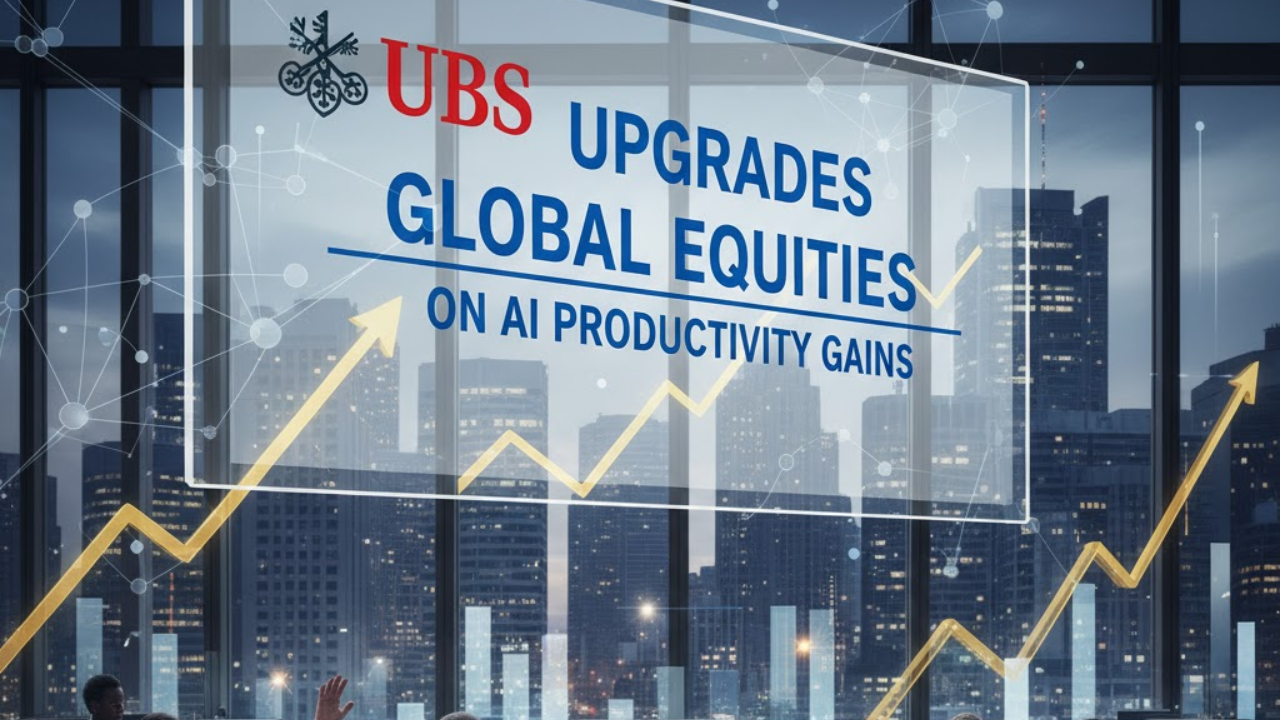
Post by : Meena Rani
In October 2025, UBS Global Wealth Management upgraded its global equities outlook from “neutral” to “attractive.” The investment bank cited accelerated productivity gains from artificial intelligence, improved corporate earnings visibility, and a favorable macroeconomic backdrop as the key reasons for this shift.
UBS also raised its target for major equity indices, reflecting growing confidence that the global rally is not over yet. Their updated projections suggest that AI is no longer just a technological trend — it’s becoming a structural driver of profitability and global growth.
The upgrade marks a significant turning point in investor sentiment. While 2024 was dominated by inflation fears and interest rate concerns, 2025 has seen optimism return on the back of AI adoption and easing monetary conditions.
UBS’s research emphasizes that the ongoing wave of corporate investment in AI is delivering tangible productivity improvements across sectors. Companies are automating workflows, streamlining supply chains, and improving decision-making with real-time data analytics.
These advances are beginning to reflect in corporate earnings. For instance, manufacturing firms using AI-powered predictive maintenance are reducing operational costs, while service industries are optimizing labor through automation. The financial sector, too, is leveraging generative AI for risk modeling and client interaction — resulting in efficiency gains.
UBS believes this transformation is not hype but a fundamental shift in how economies generate output. Unlike previous tech bubbles, AI adoption today is being integrated into business operations rather than being purely speculative.
The global monetary landscape in 2025 is also favoring equities. After a period of aggressive tightening, central banks in major economies are signaling rate cuts or at least policy stability. Lower rates reduce borrowing costs, boost corporate spending, and make equities more attractive compared to bonds.
Additionally, inflation has moderated in most developed markets, allowing room for capital to flow into risk assets. This macro backdrop complements the AI-led optimism, creating a “sweet spot” for equities.
UBS notes that corporate earnings are more stable than anticipated. Despite macro uncertainties, companies in technology, industrials, and consumer sectors are reporting better-than-expected margins. The rise of digital business models, AI-based analytics, and energy efficiency improvements have helped stabilize profitability.
Emerging markets are also showing resilience, particularly in Asia, where AI hardware, semiconductor, and manufacturing sectors are gaining traction. UBS expects this regional momentum to continue as supply chains diversify.
Several long-term themes reinforce UBS’s optimism:
Digital transformation: Continued investment in AI, automation, and data infrastructure.
Energy transition: Green energy projects supported by technology integration.
Supply chain diversification: Relocation of manufacturing closer to consumption hubs.
Demographic advantage: Workforce growth and technological literacy driving productivity.
Together, these themes point toward sustainable growth rather than short-lived cycles.
Following UBS’s announcement, global stock markets extended their gains. The MSCI World Index reached new highs, with both developed and emerging markets participating in the rally. Investors interpreted UBS’s move as validation that the equity bull cycle could continue into 2026.
Tech-heavy indices benefited the most, but cyclicals — including industrials, logistics, and consumer goods — also saw renewed investor interest. The broad-based nature of this rally indicates that AI-driven productivity is affecting multiple sectors beyond technology.
Global investment funds have seen a noticeable uptick in equity inflows, particularly in North America and Asia. Institutional investors are reallocating from cash and bonds into equities, encouraged by signs of policy stability and earnings growth.
Asia, with its strong technology manufacturing base, has emerged as a key beneficiary of this trend. Markets like Taiwan, South Korea, and India have attracted heavy foreign investment as part of the AI hardware and data infrastructure boom.
UBS acknowledges that valuations are elevated but argues that they are justified by improving earnings outlooks. The current price-to-earnings ratios for major indices reflect future productivity rather than speculative exuberance.
Still, the firm cautions against overexposure to highly concentrated AI stocks. The best approach, it says, is balanced exposure across the AI value chain — semiconductors, data centers, software, and cloud providers — rather than betting solely on headline tech giants.
Rather than focusing solely on major AI developers, investors can consider diversification across enabling industries:
Semiconductors: Supplying hardware to power AI systems.
Cloud infrastructure: Hosting data-heavy models.
Software services: Providing AI solutions to enterprises.
Automation tools: Enabling manufacturing and logistics efficiency.
This approach spreads risk while maintaining exposure to the overall AI productivity theme.
While the AI narrative supports aggressive positioning, maintaining some allocation to defensive sectors such as healthcare, utilities, and consumer staples remains prudent. These sectors can cushion portfolios during short-term volatility or corrections.
UBS advises investors to focus on companies with proven profitability and consistent cash flows. Firms that demonstrate measurable productivity gains from AI adoption are likely to outperform speculative startups or overhyped ventures.
As the rally matures, there may be rotations between sectors and regions. For example, capital may move from the U.S. to emerging markets or from pure tech plays to traditional sectors adopting AI. Staying alert to these shifts can help investors optimize entry and exit points.
Given the strong run-up in prices, short-term corrections are possible. Investors should use these pullbacks to accumulate high-quality assets rather than panic selling.
Some analysts warn of an emerging valuation bubble similar to the early 2000s tech boom. However, UBS differentiates the current AI cycle from previous bubbles by highlighting its tangible impact on productivity and profitability.
Still, investors should remain cautious. If earnings growth fails to match market expectations, a valuation correction could occur.
Governments worldwide are introducing AI regulations related to data privacy, ethics, and algorithm transparency. Any sudden policy shifts or taxation changes on digital businesses could affect earnings projections.
Tensions in trade and technology transfers remain a potential disruptor. Restrictions on chip exports or cross-border data flows could temporarily slow AI growth. Investors should factor these uncertainties into their regional strategies.
Although the interest rate outlook is favorable now, unexpected inflation spikes or delayed rate cuts could unsettle markets. Maintaining some exposure to short-duration bonds or cash equivalents can provide liquidity and safety.
UBS’s outlook is part of a broader economic narrative: the belief that AI adoption will revive global productivity, which has been stagnant for years. Automation, predictive analytics, and generative models can drastically reduce inefficiencies across industries.
For instance, AI-enabled logistics can optimize delivery routes, reduce fuel consumption, and minimize human error. In manufacturing, machine learning can predict equipment failure before it occurs, reducing downtime and costs.
These real-world gains are why institutions like UBS are optimistic about long-term earnings growth and equity valuations.
While AI improves productivity, it also alters labor markets. Routine tasks are being automated, pushing workers toward higher-skilled roles. UBS predicts that AI will lead to “task reallocation” rather than mass unemployment, provided governments and companies invest in reskilling programs.
Winners: Technology, semiconductors, logistics, energy efficiency, healthcare AI, and data infrastructure.
Losers: Low-tech industries resistant to digital transformation or dependent on outdated labor models.
UBS expects a gradual divergence where tech-integrated sectors outperform over the long term.
AI Adoption Rates: Track enterprise-level spending on AI infrastructure and software.
Earnings Revisions: Observe whether corporate analysts continue to upgrade earnings forecasts.
Central Bank Policies: Interest rate cuts could provide further equity tailwinds.
Valuation Trends: Monitor if price-to-earnings ratios stabilize or expand further.
Sector Rotation: Watch for capital movement from pure tech plays to broader industrial and service sectors.
Regulatory Announcements: AI ethics and antitrust measures could influence specific stocks.
UBS’s upgrade represents a structural confidence in the global economy’s adaptability. The fusion of AI technology, digital infrastructure, and monetary flexibility is fostering a new investment cycle that could sustain for several years.
For long-term investors, this is a reminder to stay focused on innovation, productivity, and global diversification. AI may not only redefine industry productivity but also reshape how investors perceive value creation in equities.
Disclaimer:
This article is for informational and editorial purposes only. It does not constitute investment, financial, or trading advice. Readers are advised to conduct their own research or consult professional advisors before making investment decisions.
UBS, global equities, AI investment, productivity gains, stock market outlook, AI-driven growth, investor sentiment, financial markets 2025










Bengaluru-Mumbai Superfast Train Approved After 30-Year Wait
Railways approves new superfast train connecting Bengaluru and Mumbai, ending a 30-year demand, easi

Canada Post Workers Strike Halts Nationwide Mail and Parcel Services
Canada Post halts operations as CUPW strike disrupts mail and parcel delivery nationwide amid disput

PM Modi Launches BSNL ‘Swadeshi’ 4G Network, 97,500 Towers Built
India enters global telecom league as PM Modi inaugurates BSNL’s indigenous 4G, connecting 26,700 vi

India’s Iconic MiG‑21 Takes Final Flight After Six Decades of Service
After 60 years India retires its MiG‑21 fighter jet, a legendary yet controversial warplane marking

Hindustan Zinc unveils AI hotspot monitoring at Debari smelter
Hindustan Zinc launches AI-powered Switchyard Hotspot Monitoring at Debari smelter to cut outages bo

Chinese experts worked inside sanctioned Russian drone plant
Chinese drone specialists visited IEMZ Kupol supplying parts and drones via intermediaries, deepenin